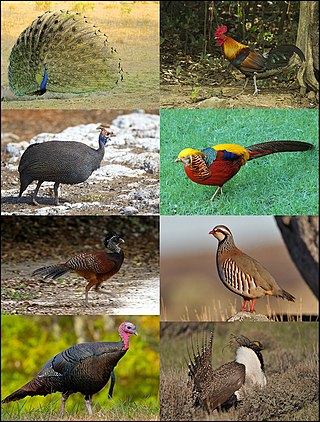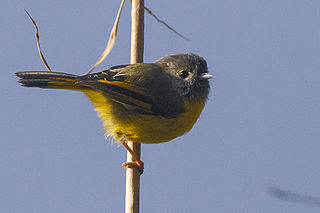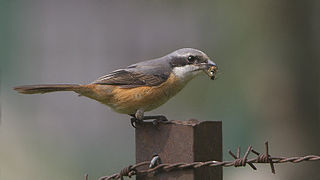
Pheasants are birds of several genera within the family Phasianidae in the order Galliformes. Although they can be found all over the world in introduced populations, the pheasant genera's native range is restricted to Eurasia. The classification "pheasant" is paraphyletic, as birds referred to as pheasants are included within both the subfamilies Phasianinae and Pavoninae, and in many cases are more closely related to smaller phasianids, grouse, and turkey than to other pheasants.

Galliformes is an order of heavy-bodied ground-feeding birds that includes turkeys, chickens, quail, and others. Gallinaceous birds, as they are called, are important in their ecosystems as seed dispersers and predators, and are often reared by humans for their meat and eggs, or hunted as game birds.

The golden pheasant, also known as the Chinese pheasant, and rainbow pheasant, is a gamebird of the order Galliformes and the family Phasianidae (pheasants). The genus name is from Ancient Greek khrusolophos, "with golden crest", and pictus is Latin for "painted" from pingere, "to paint".

The blood pheasant or blood partridge is a galliforme bird in the pheasant family Phasianidae and the only species in the genus Ithaginis. It is a relatively small, short-tailed pheasant that is widespread in the lower Himalayas ranging across North and East India, Nepal, Bhutan, South China and northern Myanmar. It has been classified as Least Concern on the IUCN Red List since 2009, and the global blood pheasant population is thought to be stable.

The Himalayan monal, also called Impeyan monal and Impeyan pheasant, is a pheasant native to Himalayan forests and shrublands at elevations of 2,100–4,500 m (6,900–14,800 ft). It is part of the family Phasianidae and is listed as Least Concern on the IUCN Red List. It is the national bird of Nepal, where it is known as the danphe or danfe, and state bird of Uttarakhand, India, where it is known as a monal. The scientific name commemorates Lady Mary Impey, the wife of the British chief justice of Bengal, Sir Elijah Impey.

The Tibetan partridge is a gamebird in the pheasant family Phasianidae of the order Galliformes. They are found widely across the Tibetan Plateau and have some variations in plumage across populations. They forage on the ground in the sparsely vegetated high altitude regions, moving in pairs during the summer and in larger groups during the non-breeding season. Neither males nor females have spurs on their legs.

The Chinese bamboo partridge is a small Galliform bird. It is one of three species in the genus Bambusicola, along with the mountain bamboo partridge of the Himalayas, and the Taiwan bamboo partridge of Taiwan. Chinese bamboo partridge is a monotypic species.

The Palawan peacock-pheasant is a medium-sized bird in the family Phasianidae endemic to the island of Palawan in the Philippines. The spectacular male has a black body with blue marks on the wings, a grayish, finely speckled back and tail with blue peacock “eyes,” white marks on the face, and a red eye-ring. Females are mostly brown but with a white face. It is known as tandikan in the some local Palawano, Tagbanwa, and Batak languages of Palawan. It is featured prominently in the culture of the indigenous people of Palawan. The bird is also depicted in the official seal of the city of Puerto Princesa.

The brown eared pheasant is a large, 96– to 100-cm-long, dark brown pheasant endemic to the mountain forests of northeastern China. The species was first described by Robert Swinhoe in 1863. It has stiff white ear coverts behind the eyes, which look like a moustache. The crown is black with red bare facial skin and its tail of 22 elongated, white feathers is curved, loose and dark-tipped. Both sexes are similar in plumage.

Eared pheasants are pheasants from the genus Crossoptilon in the family Phasianidae.

Reeves's pheasant is a large pheasant within the genus Syrmaticus. It is endemic to China. It is named after the British naturalist John Reeves, who first introduced live specimens to Europe in 1831.

The blue eared pheasant is a large pheasant endemic to China. Although it is considered rare, the blue eared pheasant is evaluated as of least concern on the IUCN Red List of Threatened Species.

The Chinese leaf warbler is a species of Old World warbler in the family Phylloscopidae. Its natural habitats are subtropical or tropical dry forests and subtropical or tropical high-altitude shrubland. It is found only in China.

The Tibetan eared pheasant, also called Elwes' eared pheasant, is a species of bird in the family Phasianidae found in southeast Tibet and adjacent northern India, usually between 3,000 and 5,000 m elevation, but has been seen down to 2,280 m (7,500 ft) in winter. The species is named after Henry John Harman.

Buff-throated monal-partridge, also known as buff-throated partridge or Szechenyi's monal-partridge, is a member of the family Phasianidae in the order Galliformes. It is endemic to western China.

The golden-breasted fulvetta is a species of songbird found in Bhutan, China, India, Myanmar, Nepal, and Vietnam. Its natural habitats are temperate forests and subtropical or tropical moist montane forests.

The grey-backed shrike is a bird in the family Laniidae inhabiting South-east Asia.
Sharpe's rosefinch is a species of finch in the family Fringillidae. It is found in central China and far northern Myanmar. Its natural habitat is subtropical or tropical high-altitude shrubland. It was formerly considered to be a subspecies of the spot-winged rosefinch.

The Three Parallel Rivers of Yunnan Protected Areas is a UNESCO World Heritage Site in Yunnan province, China. It lies within the drainage basins of the upper reaches of the Jinsha (Yangtze), Lancang (Mekong) and Nujiang (Salween) rivers, in the Yunnan section of the Hengduan Mountains.


















